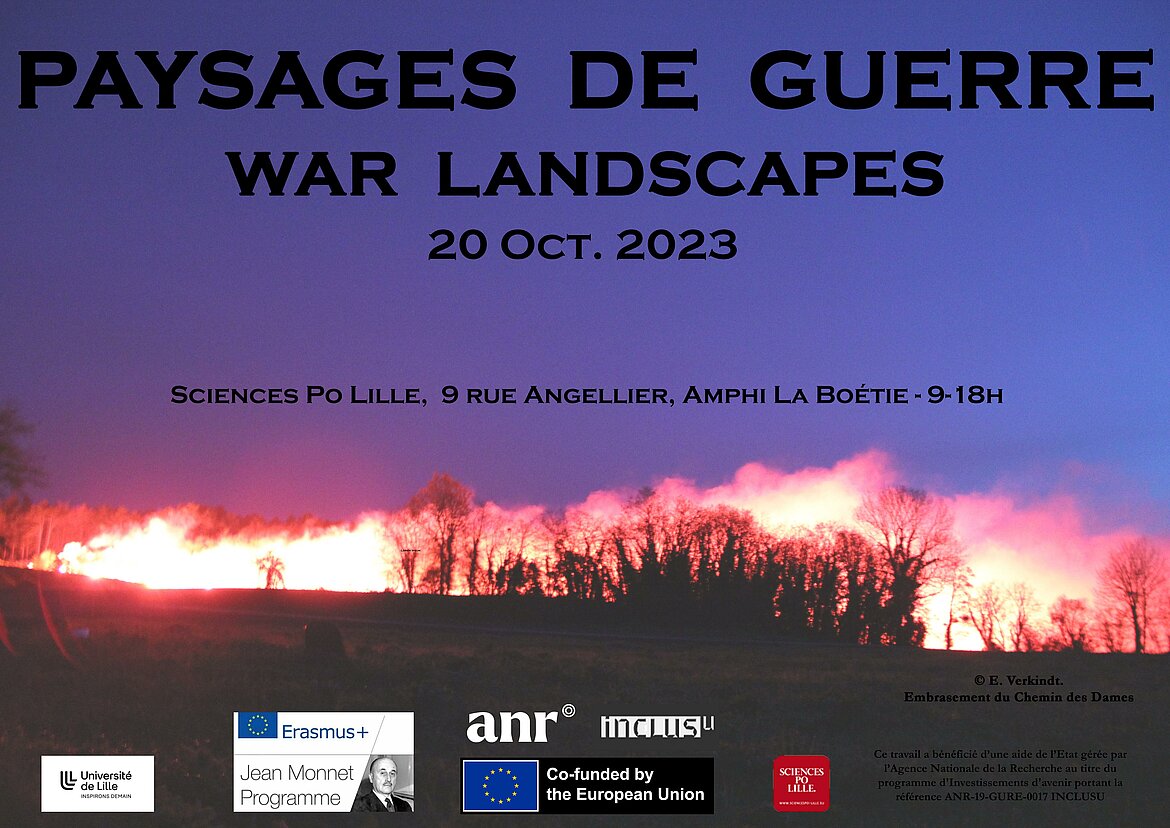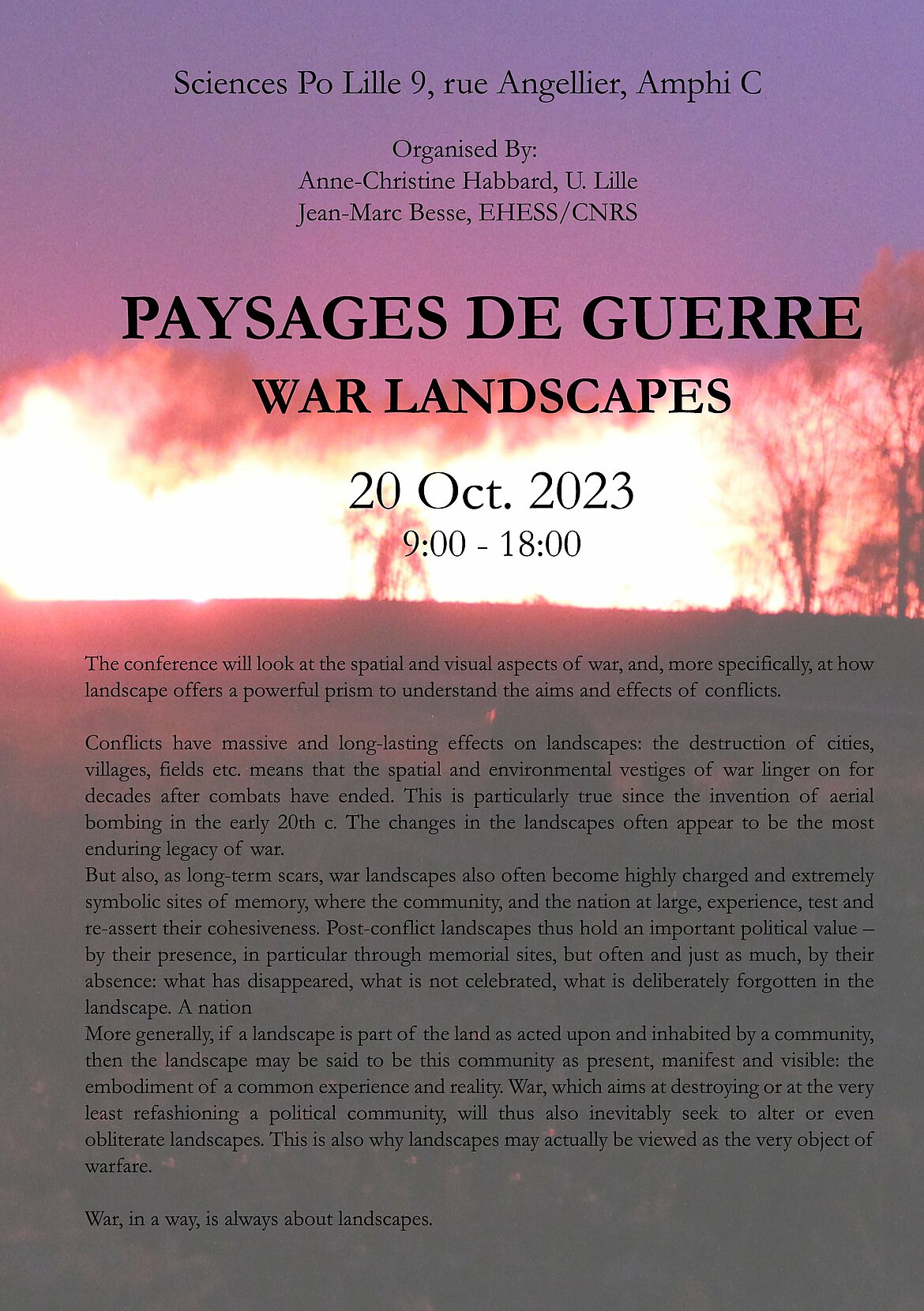Conférence "Paysages de guerre" / Conference 'War Landscapes'
Conférence internationale interdisciplinaire / International interdisciplinary conference
Programme:
09:00 | Jean-Marc Besse, EHESS, France: Introduction
09:30 | Etienne Verkindt, France : 'Le Paysage de mémoire de la Première Guerre mondiale et son jumeau numérique'
10:15 | Dmytro Chepurnyi, Soniakh Digest, Ukraine: 'Ukraine: Landscape After the Deoccupation' [via Zoom]
11:00 | Jared Stark, Eckerd University, U.S.A.: 'Landscape After Auschwitz'
LUNCH BREAK
13:30 | Luba Jurgenson, Sorbonne University, France : 'Paysages palimpsestes'
14:15 | Anne-Christine Habbard, University of Lille, France : 'Re-thinking the Laws of War through the Prism of Landscape'
15:00 | Eric Masson, University of Lille, France: 'Paysages en guerre: la micro-échelle au télescope'
15:45 | David Biggs, University of California Riverside, U.S.A.: 'Bases, Bomb Craters, and Spray Paths: A Landscape Approach to the Vietnam War' [via Zoom]
Join us also via ZOOM meeting here!
NB: The Conference will be delivered in English and in French with simultaneous translation.
Abstract:
The conference will look at the spatial and visual aspects of war, and, more specifically, at how landscape offers a powerful prism to understand the aims and effects of conflicts.
Conflicts have massive and long-lasting effects on landscapes: the destruction of cities, villages, fields etc. means that the spatial and environmental vestiges of war linger on for decades after combats have ended. This is particularly true since the invention of aerial bombing in the early 20th c. The changes in the landscapes frequently appear to be the most enduring legacy of war.
But also, as long-term scars, war landscapes also often become highly charged and extremely symbolic sites of memory, where the community, and the nation at large, experience, test and re-assert their cohesiveness. Post-conflict landscapes thus hold an important political value – by their presence, in particular through memorial sites, but often and just as much, by their absence: what has disappeared, what is not celebrated, what is deliberately forgotten in the landscape. War landscapes are an essential part of how the nation’s history, and its narrative, are elaborated.
More generally, if a landscape is part of the land as acted upon and inhabited by a community, then the landscape may be said to be this community as present, manifest and visible: the embodiment of a common experience and reality, the world made significant and permanent. War, which aims at destroying or at the very least refashioning a political community, will thus also inevitably seek to alter or even obliterate landscapes. This is also why landscapes may actually be viewed as the very object of warfare.
War, in a way, is always about landscapes.
For more information, feel free to contact Anne-Christine Habbard at anne-christine.habbard@univ-lille.fr



![Programme: 09:00 | Jean-Marc Besse, EHESS, France: Introduction 09:30 | Etienne Verkindt, France : 'Le Paysage de mémoire de la Première Guerre mondiale et son jumeau numérique' 10:15 | Dmytro Chepurnyi, Soniakh Digest, Ukraine: 'Ukraine: Landscape After the Deoccupation' [via Zoom] 11:00 | Jared Stark, Eckerd University, U.S.A.: 'Landscape After Auschwitz' LUNCH BREAK 13:30 | Luba Jurgenson, Sorbonne University, France : 'Paysages palimpsestes' 14:15 | Anne-Christine Habbard, University of Lille, France : 'Re-thinking the Laws of War through the Prism of Landscape' 15:00 | Eric Masson, University of Lille, France: 'Paysages en guerre: la micro-échelle au télescope' 15:45 | David Biggs, University of California Riverside, U.S.A.: 'Bases, Bomb Craters, and Spray Paths: A Landscape Approach to the Vietnam War' [via Zoom]](/fileadmin/_processed_/1/6/csm_V5_flier_back_01_9c886f5f64.jpg)

